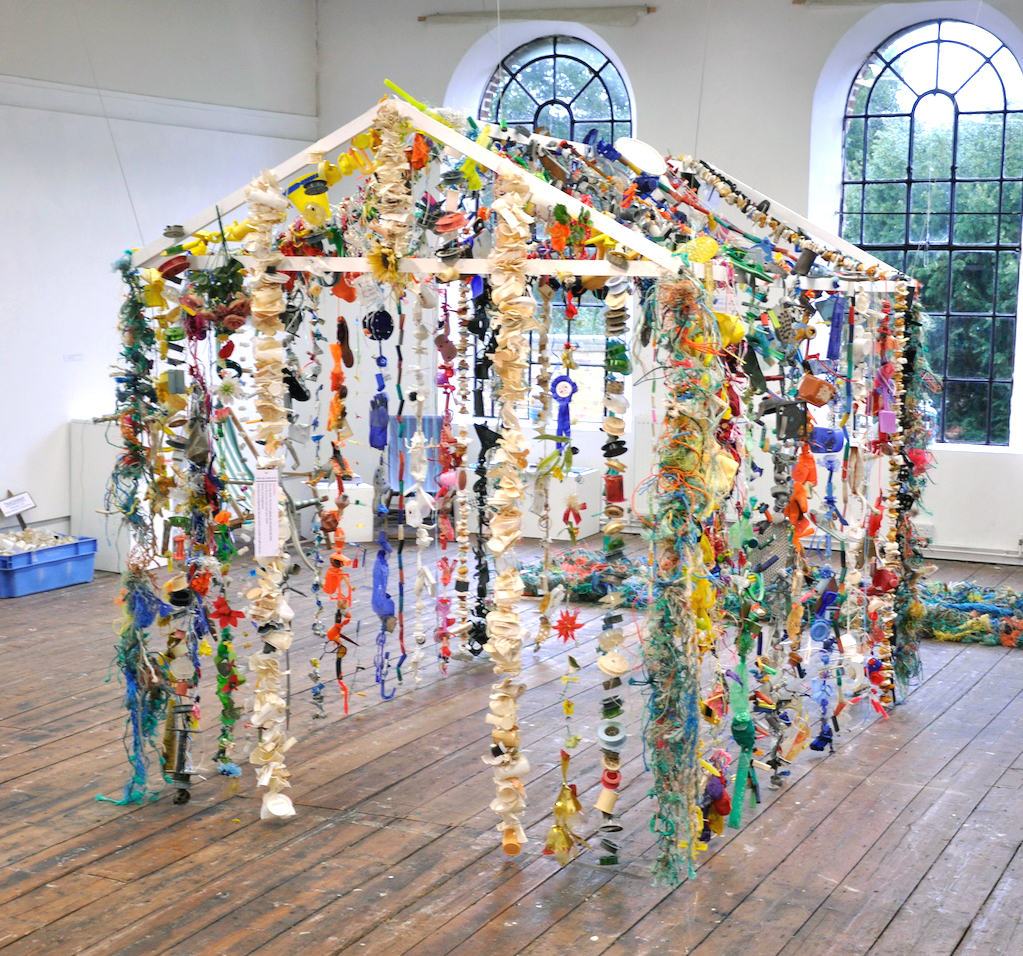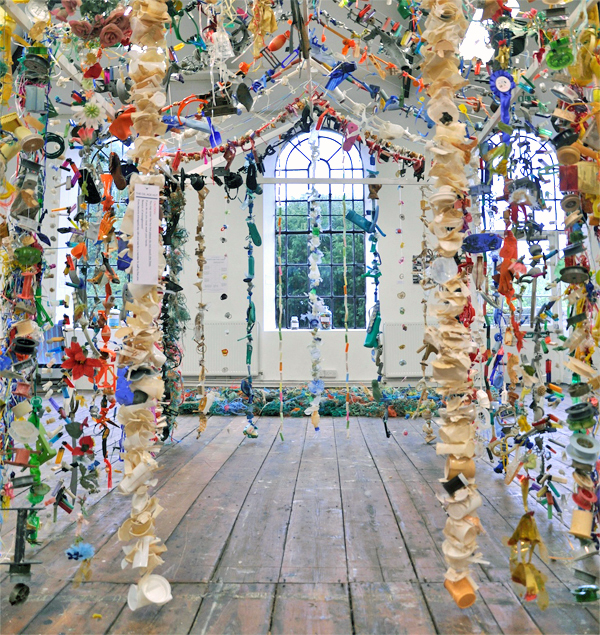
| |
| home |
| projects |
| contact me |
| links |
THE OIL AGE HUT - hutliving in the age of oil...
sxxc

What is the Oil Age Hut?
We belong to an era which has developed the technology to unlock and utilise millions-years-old deposits of ‘stored sunshine’ preserved as fossil fuels, including oil. In just over a century we will have used the lion’s share of these precious reserves.
Plastics, made possible by the discovery of oil, are an enduring symbol of our age and, due to their special ability to survive for eternity, provide a lasting and meaningful legacy from this era of abundance.
This is the world we have manufactured and which we inhabit, and which is represented by The Oil Age Hut.
What is it made of?
The Oil Age Hut is made from plastic litter, washed up from the sea and which I have personally collected - mostly from beaches on the North Sea near my home. The items used in its construction are some of the 46000* pieces of plastic marine debris that I collected in an attempt to ‘save’ one square mile of sea.
* A UN Environment Programme report,“Ecosystems and Biodiversity in Deep Waters and High Seas”, in 2006 estimated that on average there are 46,000 pieces of plastic litter floating in every square mile of ocean worldwide, causing the death of over one million seabirds and over 100,000 marine mammals and turtles every year due to entanglement with or swallowing of litter.
Why make an oil age hut?
- the materials are free and can be sourced locally on a beach near you
- there is an unlimited supply - discarded plastics surround us. And there are 46000 pieces floating in every square mile of ocean too!
- gathering construction materials from our beaches helps keep our beaches and seas clean. This, in turn, will help to protect our wildlife.
- it is 100% recycled
- re-using plastics in huts saves landfill space
- it’s low tech - anyone can make one...
- your hut can capture history! You will be creating a living - and everlasting - museum of how humans lived in the age of oil. Some of the items in my hut are decades old, dating even from the birth of the Plastic Age! Every item has unknown stories to tell about its travels - and about the way we live now...
- it’s multi-cultural: items of plastic from all over the world wash up on our beaches. Plastics in the sea can travel thousands of miles! When it comes to marine litter, the local truly is global.
- you can add to it: if you get fed up with items around your home, things get broken or you receive unwanted gifts, why not use them to build an extension or reinforce your walls?
- it’s colourful and it’s unique - each item has been weathered by nature in a distinctive way: no-one’s hut will ever look like yours! And if you get bored with the style of your hut, you can easily change it round to give a give your home a fresh look.
- the materials will probably last forever.
How to make an oil age hut of your own
To make an oil age hut like the one pictured here, simply collect the plastics that wash up on the shoreline each time you visit the beach. Each tide brings in a new harvest of unique plastics, ready for you to collect and use. Get your family and friends to help you - there is more than enough for everyone. In fact, the UNEP estimates that the amount of plastic in the sea is doubling every two or three years.
Sort your plastics by colour or type if desired (this is your chance to get creative) and then just get building! But be sure to read the warnings below before you start!
A legacy for our children
Approximately 9% of the world’s oil is used to make plastics and demand for oil may soon exceed supply. Some scientists believe that household plastics could be the oil reserves of tomorrow. In fact, a ‘safe and user-friendly’ machine is already being developed in Japan that will allow the small-scale harvesting of oil from plastics so our homes really could become ‘the oil fields of the future’...
Be prepared! The Oil Age Hut provides a convenient and useful way to sequester (store) oil locally, potentially providing a ready source of oil for your children and future generations to ‘mine’ for their energy needs.
Plastics - even ‘disposable’ ones - last indefinitely in the natural environment so they will always be there for you and your family when you need them. What better legacy for our children!
IMPORTANT WARNINGS
|
||||
The Oil Age Hut is not for you??
Don't worry there are still things you can do to make a difference. Here's some ideas for what we can all do to help reduce plastics pollution:
- Reduce, repair, re-use and re-cycle – be conscious of all that you buy, and be sure to avoid ‘disposable’ plastic products and anything with excessive packaging. Plastics are highly dependent on oil for their production - start treating plastics as the rare resource that they soon will be!
- Refuse plastic carrier bags wherever possible - try always to carry an alternative with you.
- Avoid buying takeaway drinks in plastic bottles and cups. Carry a re-usable container if you can.
- Don't take part in balloon releases and never let go!
- Never flush plastics (sanitary towels, tampon applicators, cottonbuds) down the loo - and don’t use tampon brands with plastic applicators.
- Demand more and better recycling facilities in your area - out and about, not just in the home.
- Take part in river and beach clean-ups (for instance, Beachwatch) - or organise one yourself.
- Every time you see litter, pick it up and dispose of it properly. When visiting beaches, take a spare bag to pick up any litter that you see.
If you live near the sea or a river, your storm drains may be washing rubbish out to sea. Demand that these are eliminated. - Support organisations such as Greenpeace, your local Wildlife Trust and the Marine Conservation Society, all of who are lobbying for better protection of our oceans and wildlife.
- Finally, why not start your own campaign at your local school or library - ‘Plastic Fantastic?’ posters are available on my website www.flyintheface.com and lots of useful links for further information. Do email me and let me know how you get on!

Photographs of Fran's Oil Age Hut were taken at Bridport Arts Centre, Dorset.
The Oil Age Hut formed part of a commission by Burr Projects C.I.C. for Hutliving Here and There at the Arts Centre in May 2012.